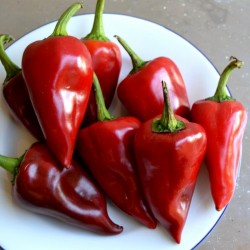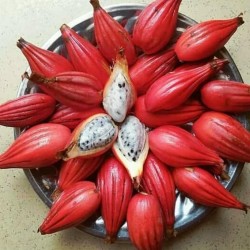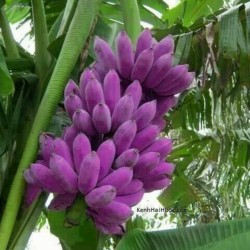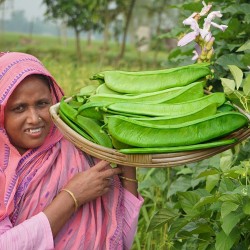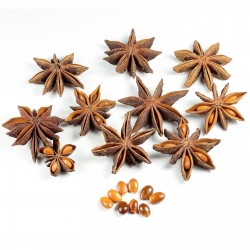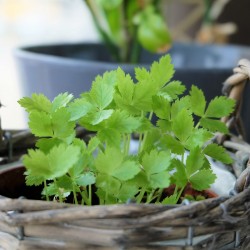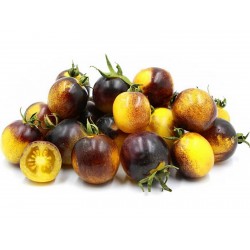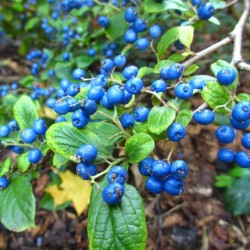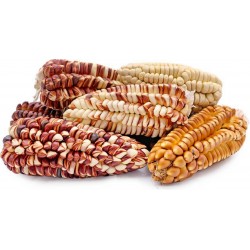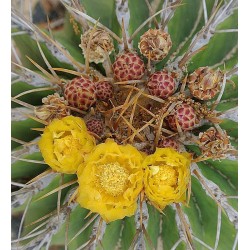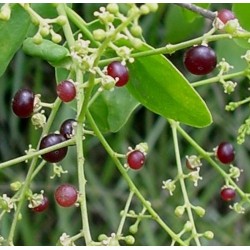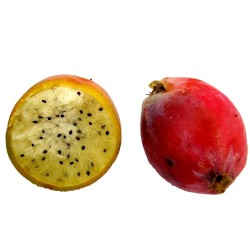Seeds Gallery Com,
5/
5
<h2 class=""><strong>Star Anise Seeds (Illicium verum)</strong></h2>
<h2><span style="color: #ff0000;"><strong>Price for Package of 3 seeds.</strong></span></h2>
<p><i><b>Illicium verum</b></i><span> </span>is a medium-sized<span> </span>evergreen<span> </span>tree native to northeast<span> </span>Vietnam<span> </span>and southwest China. A spice commonly called<span> </span><b>star anise</b>,<span> </span><b>staranise</b>,<span> </span><b>star anise seed</b>,<span> </span><b>Chinese star anise</b>, or<span> </span><b>badiane</b><span> </span>that closely resembles<span> </span>anise<span> </span>in flavor is obtained from the star-shaped<span> </span>pericarps<span> </span>of the fruit of<span> </span><i>I. verum</i><span> </span>which are harvested just before ripening. Star anise oil is a highly fragrant oil used in cooking, perfumery, soaps, toothpastes, mouthwashes, and skin creams. About 90% of the world's star anise crop is used for extraction of<span> </span>shikimic acid, a chemical intermediate used in the synthesis of<span> </span>oseltamivir<span> </span>(Tamiflu).</p>
<h2><span class="mw-headline" id="Nomenclature">Nomenclature</span></h2>
<table class="infobox">
<tbody>
<tr>
<td colspan="2">Star anise</td>
</tr>
<tr>
<th scope="row">Chinese</th>
<td><span lang="zh-hani" title="Chinese language text" xml:lang="zh-hani">八角</span></td>
</tr>
<tr>
<th scope="row">Literal meaning</th>
<td>"eight-horns"</td>
</tr>
<tr>
<td colspan="2">
<table class="collapsible collapsed mw-collapsible mw-collapsed mw-made-collapsible">
<tbody>
<tr>
<th colspan="2"><span class="mw-collapsible-toggle mw-collapsible-toggle-default mw-collapsible-toggle-collapsed">show</span>Transcriptions</th>
</tr>
</tbody>
</table>
</td>
</tr>
</tbody>
</table>
<p><i>Illicium</i><span> </span>comes from the Latin<span> </span><i>illicio</i><span> </span>meaning "entice". In<span> </span>Persian, star anise is called<span> </span><span lang="fa" title="Persian language text" xml:lang="fa">بادیان</span><span> </span><i>bādiyān</i>, hence its French name<span> </span><i><i>badiane</i></i>.</p>
<h2><span class="mw-headline" id="Use">Use</span></h2>
<h3><span class="mw-headline" id="Culinary_use">Culinary use</span></h3>
<div class="thumb tright">
<div class="thumbinner"><img alt="" src="https://upload.wikimedia.org/wikipedia/commons/thumb/a/aa/Star_Aniseed_back.jpg/220px-Star_Aniseed_back.jpg" width="220" height="190" class="thumbimage" />
<div class="thumbcaption">
<div class="magnify"></div>
Reverse side of fruit</div>
</div>
</div>
<div class="thumb tright">
<div class="thumbinner"><img alt="" src="https://upload.wikimedia.org/wikipedia/commons/thumb/f/f2/Illicium_verum00.jpg/220px-Illicium_verum00.jpg" width="220" height="396" class="thumbimage" />
<div class="thumbcaption">
<div class="magnify"></div>
Plate from<span> </span>François-Pierre Chaumeton's 1833<span> </span><i>Flore Medicale</i></div>
</div>
</div>
<p>Star anise contains<span> </span>anethole, the same compound that gives the unrelated<span> </span>anise<span> </span>its flavor. Recently, star anise has come into use in the<span> </span>West<span> </span>as a less expensive substitute for anise in baking, as well as in<span> </span>liquor<span> </span>production, most distinctively in the production of the<span> </span>liqueur<span> </span>Galliano.<sup id="cite_ref-2" class="reference">[2]</sup><span> </span>Star anise enhances the flavour of meat.</p>
<p>It is used as a spice in preparation of<span> </span><i>biryani</i><span> </span>and<span> </span><i>masala chai</i><span> </span>all over the<span> </span>Indian subcontinent. It is widely used in<span> </span>Chinese cuisine, and in<span> </span>Malay<span> </span>and<span> </span>Indonesian cuisines. It is widely grown for commercial use in China, India, and most other countries in Asia. Star anise is an ingredient of the traditional<span> </span>five-spice powder<span> </span>of Chinese cooking. It is also a major ingredient in the making of<span> </span><i>phở</i>, a<span> </span>Vietnamese<span> </span>noodle soup.</p>
<p>It is also used in the French recipe of mulled wine, called<span> </span><i>vin chaud</i><span> </span>(hot wine). If allowed to steep in coffee, it deepens and enriches the flavor. The pods can be used in this manner multiple times by the pot-full or cup, as the ease of extraction of the taste components increases with the permeation of hot water.</p>
<h3><span class="mw-headline" id="Drug_precursor">Drug precursor</span></h3>
<div class="hatnote navigation-not-searchable">Main article:<span> </span>Oseltamivir total synthesis</div>
<p>Star anise is the major source of the chemical compound<span> </span>shikimic acid, a primary<span> </span>precursor<span> </span>in the<span> </span>pharmaceutical<span> </span>synthesis of the antiinfluenza<span> </span>drug,<span> </span>oseltamivir<span> </span>(Tamiflu).<sup id="cite_ref-Bilal_4-0" class="reference">[4]</sup><sup id="cite_ref-Drugs_5-0" class="reference">[5]</sup><sup id="cite_ref-Wang_6-0" class="reference">[6]</sup>An industrial method for the production of shikimic acid using<span> </span>fermentation<span> </span>of<span> </span><i>E. coli</i><span> </span>bacteria was discovered in 2005,<sup id="cite_ref-7" class="reference">[7]</sup><sup id="cite_ref-8" class="reference">[8]</sup><span> </span>and applied in the<span> </span>2009 swine flu outbreak<span> </span>to address Tamiflu shortages, also causing price increases for star anise as a<span> </span>raw material<span> </span>of shikimic acid.<sup id="cite_ref-lim_9-0" class="reference">[9]</sup><span> </span>As of 2018, fermentation of<span> </span><i>E. coli</i><span> </span>was the manufacturing process of choice to produce shikimic acid for synthesis of Tamiflu.<sup id="cite_ref-Drugs_5-1" class="reference"></sup></p>
<h2><span class="mw-headline" id="Toxicity">Toxicity</span></h2>
<p>Japanese star anise<span> </span>(<i>Illicium anisatum</i>), a similar tree, is highly toxic and inedible; in Japan, it has instead been burned as<span> </span>incense. Cases of illness, including "serious<span> </span>neurologicaleffects, such as seizures", reported after using star anise tea, may be a result of deliberate<span> </span>economically motivated adulteration<span> </span>with this species. Japanese star anise contains the<span> </span>neurotoxin<span> </span>anisatin,<sup id="cite_ref-PubChem_10-0" class="reference">[10]</sup><span> </span>which also causes severe<span> </span>inflammation<span> </span>of the<span> </span>kidneys<span> </span>(nephritis),<span> </span>urinary tract, and<span> </span>digestive organs<span> </span>when ingested.</p>
<p>Swamp star anise<span> </span><i>Illicium parviflorum</i><span> </span>is a similar tree found in the Southern United States, and due to its toxicity, it should not to be used for folk remedies or as a cooking ingredient.</p>
<h2><span class="mw-headline" id="Standardization_of_its_products_and_services">Standardization of its products and services</span></h2>
<ul>
<li>ISO 676:1995 - contains the information about the nomenclature of the variety and cultivars</li>
</ul>
<h3><span class="mw-headline" id="Identification">Identification</span></h3>
<ul>
<li>Refer to the 4th edition of the<span> </span><i>European Pharmacopoeia</i><span> </span>(1153)</li>
</ul>
<h3><span class="mw-headline" id="Differentiation_from_other_species">Differentiation from other species</span></h3>
<p>Joshi<span> </span><i>et al.</i><span> </span>have used<span> </span>fluorescent microscopy<span> </span>and<span> </span>gas chromatography<sup id="cite_ref-reiivh_14-0" class="reference">[14]</sup><span> </span>to distinguish the species, while Lederer<span> </span><i>et al.</i><span> </span>employed<span> </span>thin layer chromatography<span> </span>with<span> </span>HPLC-MS/MS</p>
<p><span style="color: inherit; font-family: inherit; font-size: 30px;">How to Grow Star Anise From Seeds</span></p>
<p>Star anise trees (<em>Illicium verum</em>) grow easily from seed. Star anise trees grow in U.S. Department of Agriculture plant hardiness zones 7 through 10 and do best with a soil pH between 4 and 6 that's rich in organic matter. They grow in either full sun or part shade.</p>
<p><span style="color: inherit; font-family: inherit; font-size: 30px;">Preparing and Planting Star Anise Seeds</span></p>
<p>Carefully preparing and planting the seeds will give the best chance of success. Or, store the seeds in moist sand in a sealed plastic bag or container in the refrigerator for up to a month.</p>
<p><span style="color: inherit; font-family: inherit; font-size: 30px;">Step 1</span></p>
<p>Pour seed-starting potting mix into 4- to 6-inch-diameter plastic pots. Fill them to 1 to 1 1/2 inches from the top. Moisten the mix with room-temperature water. Use pots that have drainage holes in them.</p>
<p><span style="color: inherit; font-family: inherit; font-size: 30px;">Step 2</span></p>
<p>Place the seeds into a bowl filled with water. Throw away any seeds that <strong>float</strong> to the surface. They are not viable. Plant only the seeds that sink to the bottom.</p>
<p><span style="color: inherit; font-family: inherit; font-size: 30px;">Step 3</span></p>
<p>Place two or three seeds per pot on top of the moistened potting mix, spaced evenly apart. Cover the seeds with a 1/4 to 1/2 inch of a moistened seed-starting mix. Firm it gently with your fingers to remove air pockets. Set plastic water or soda bottle with the bottom cut out over the seeds. Leave the screw caps on.</p>
<p><span style="color: inherit; font-family: inherit; font-size: 30px;">Step 4</span></p>
<p>Put the containers in bright, indirect light where temperatures stay around 70 degrees Fahrenheit. Moisten the potting mix using a spray bottle with room-temperature water if it begins to dry or set the containers in 1 to 2 inches of room-temperature water for an hour or two. The water will soak up into the germination mix through the holes in the bottoms of the containers.</p>
<p><span style="color: inherit; font-family: inherit; font-size: 30px;">Step 5</span></p>
<p>Remove the screw caps from the tops of the bottles after the seeds germinate. Remove the bottles a week later. The seeds should germinate in <strong>one to two months</strong>.</p>
<p><span style="color: inherit; font-family: inherit; font-size: 30px;">Step 6</span></p>
<p>Pot the star anise tree seedlings up in individual 6- to 8-inch pots when they are 3 to 4 inches tall. Use pots with drainage holes. Pot them up using <strong>peat-based</strong> potting soil. Set them in bright, indirect light and water them with room-temperature water when the top of the potting soil begins to dry.</p>
<p><span style="color: inherit; font-family: inherit; font-size: 30px;">Step 7</span></p>
<p>Grow the star anise plants in their containers for one year. Repot them into containers 1 inch larger when they become pot-bound or when you can see the roots through the drain holes in the bottom of the container. <strong>Set them outdoors</strong> during the day in the summer when there is no danger of frost and the weather is calm and pleasant. Put them in bright shade in an area that is protected from strong winds. Continue to water them when the top of the soil begins to dry.</p>
<p><span style="color: inherit; font-family: inherit; font-size: 30px;">Step 8</span></p>
<p>Plant them outdoors in their permanent positions the following spring after any danger of frost has passed. Begin to get them used to direct sunlight two weeks before planting. Start with an hour of direct morning sunlight and increase the duration by 30 minutes or so every two days. Water them when the top 2 inches of soil feel dry. Plant multiple trees 15 to 20 feet apart. Water them generously right after planting and continue to water them as often as necessary to keep the soil lightly moist.</p>
<script src="//cdn.public.n1ed.com/G3OMDFLT/widgets.js"></script>
MHS 116 (3 S)





